Jennifer Barclay's Blog, page 6
February 5, 2017
Listening to the Waves
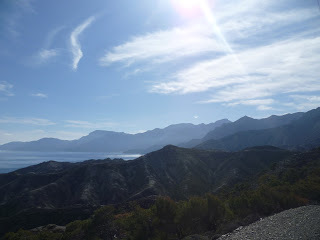
This is a peaceful time of year; except for one or two stormy days, the weather has been calm since I returned from England two weeks ago. All evening, until I fall asleep, I can hear the waves coming in to shore. I love falling asleep to the sound of the waves, and waking up with the sun. More and more anemones, like mauve and pink poppies, are carpeting the path to the beach, and under the olive trees are lush green patches of clover with yellow Bermuda buttercups.
There are few visitors to Ayios Minas valley at this time of year - just occasionally people come to look after their land, or their goats, or to hunt. Minas has been busy doing renovations to the taverna and occasionally going up to the villages to fix someone's fridge, returning with fresh goat's cheese or some interestingly fizzy pomegranate juice.
I've had three swims in the sea in the last fortnight. My editing and literary agency work has been so busy for the last few months, I've barely had time for anything else, but it's been good to have some exciting projects, and even better now that life is gradually getting back to normal. I celebrated this weekend by writing up notes from last summer, and making the most of spring-like weather today with a walk to Agnontia with Lisa.
 It's an easy walk, just following the first track from Ayios Minas up towards the road to the signposted turnoff, then winding back down again to the valley. We had a very quick cool-off in the sea, scrambled up the headland to what turned out to be a hair-raising sheer cliff, then explored the riverbed and the little old houses before heading back.
It's an easy walk, just following the first track from Ayios Minas up towards the road to the signposted turnoff, then winding back down again to the valley. We had a very quick cool-off in the sea, scrambled up the headland to what turned out to be a hair-raising sheer cliff, then explored the riverbed and the little old houses before heading back. 


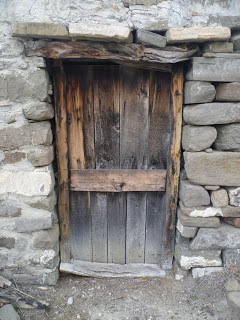


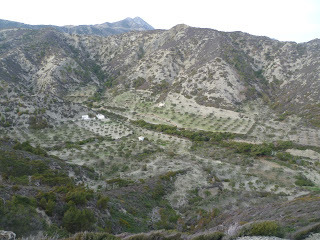
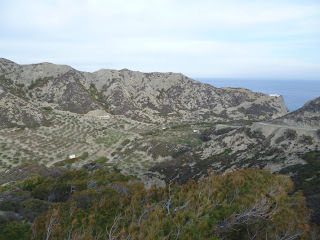 And now the clouds are pink in a dusky pale blue sky. And the only sound is the sea, and the hiss of the wood on the fire.
And now the clouds are pink in a dusky pale blue sky. And the only sound is the sea, and the hiss of the wood on the fire.
Published on February 05, 2017 08:01
September 30, 2016
Burning my fingers

Up in Olympos today, pressing laundry for the rooms, I was as usual being hasty and burning my fingers on sheets hot from the steam press. My hands are recovering from the summer, though my fingerpads are still crisscrossed with cuts in places from working in the kitchen. It’s been a summer of burning my fingers on this new adventure that befell me at Easter, when I decided to help Minas with his hotel and taverna in wild north Karpathos. This place is not so remote: on a clear day when I drive the Lada 4x4 up to the road to Olympos, I can clearly see the southwest of Rhodes; and I’ve been looking at north Karpathos on the horizon from Megalo Horio in Tilos for years – with no idea of what awaited. Yet north Karpathos feels cut off from the world in some ways. To get petrol or money you need to drive an hour to the south of the island. The post office is a souvlaki restaurant, with letters left in a box outside, and if you want something posted, Yiannis will take it next time he goes to Pigadia. Olympos was eerily quiet this last day of September, the tour groups suddenly gone, and some of the gift shops suddenly closed. One of the old ladies dressed in black (Foula’s mother? Foula, for once, wasn’t sitting outside on the steps and I missed her shouting ‘Filenada mou!’), asked how things were at Fillios – the other name for Agios Minas – and if there were still people; smiling, she said they hadn’t had a bad summer but people weren’t shopping like they used to; still, ‘Igeia!’ she said, we have our health, that’s the most important thing. I noticed two young boys with school bags and realised the children must be back at school now. The mountain village of Olympos was clear and bright in the sunshine, impossibly vertical from certain angles. I didn’t have much enthusiasm for cleaning rooms again, having told myself the last time was the final time; but the last guests had left them nicely and it didn’t take too long, and it’s always satisfying to see how pretty the rooms look when they’re fixed up with everything in place again and the sheets and towels arranged. I now remember to wipe the crazy Olympos dust off the washing line if I haven’t used it for a few days, though for once the red-painted woodwork of the hotel didn’t even look dusty – this could be the start of a lovely season. We had an early day of rain a couple of weeks ago, and since then I’ve seen and heard more birds around the valley, and dragonflies. Nikos’ wife was sitting outside Parthenon doing some lacework. I’d heard her call out ‘Yeia sou Evgenia!’ through the open door while I was cleaning the top room. It makes me happy. When I asked what beautiful thing she was making she just shrugged and smiled shyly, ‘Oh, just something to kill time…’ Minas’ aunt Miraflora came out of her doorway as we were talking and said we must come up to the village. Old Mrs Zografidis in her kafeneio waved to me. Dina in the supermarket, and the man who says I never eat, who’s packing up his shop, said it would be terrible at Agios Minas in the winter, no people… It seems word has got around that we may be staying open if we can fit the place out for winter. I told him I’d had enough company all summer and would like some peace and quiet by the sea… We shall see, I said; we can always come up to Olympos too. Dina will be there all winter, and so will Sophia – ‘Where would we go? You need money to go away!’ I bought some gifts to take with me to Tilos next week. Yes, there is still Tilos to think about... Back down at Agios Minas, there were no cars at all the beach when I arrived, but the young guy who checks the poles for the electricity company, who gave me a ride early in the summer, was back and drinking beer with his mate and Minas. Such a contrast to yesterday, when we cooked big fish for three tables of customers, and a fourth table had kalamari as they felt the last fish was too big for two people, but a couple came along later and took it. We were able to pay Stamatis the fisherman some money to fix his car, and we all sat down and ate fresh tuna, filleted and fried, with salad and fresh bread as the sun was setting.Today I left the boys to drinking beers, and I made something to eat, then went down to the beach with Lisa, had a swim and dried off in the sun and the wind. Lisa sunbathed next to me, licking my hand to make me stroke her. One couple had arrived and were sunbathing in the shelter of the cave; Lisa looked up when their umbrella blew into the sea. Another couple arrived and sat by the sea for a while but then gave up, probably finding the wind too cold, and left. Stamatis returned – ‘Kronia polla! Pos paei?’ – happy that his car is fixed and ready to pick up. Minas wanted to drive him down to pick it up tomorrow, but Stamatis said ‘Wait, let’s work a bit first, and get some fish to sell…’ He says I’m like a sister to him. I came up to the little house, the spitaki, to write. Lisa was running around with her new friend, the little terrier/poodle thing belonging to the neighbours who are working on their house. I love the cosy spitaki, one of the little single-room places the people from Olympos keep here to use when they do the olive harvest; if it didn’t rain through the ceiling, ahem, it would be perfect. I can see the blue sea through the doorway, and hear the wind in the trees all around. The bed is heaped with cotton blankets and sleeping bags. The tent – the second tent of the summer – is being phased out. The outside of it was torn up like paper by the sun and the wind, and gradually removing itself. I laughed recently when I found the bag it came in and saw it described as a ‘well-ventilated dome’. Just the mesh interior is standing now.There’s no more rushing around. All those days of getting up to clean and make breakfasts for campers, dashing to Olympos to clean rooms in time for new arrivals, dashing back to help with the lunchtime crowd, hoping to make it to the beach before dark – finished for this year at least. No more waking up in the night, dreaming that there are customers outside waiting to be served. I can still eat chips and ice cream and everything else I can lay my hands on and still look skinny, after the summer’s activity, but this too shall pass. I am slowly getting back into another rhythm. Fingers burning to write.


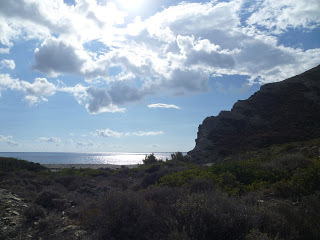


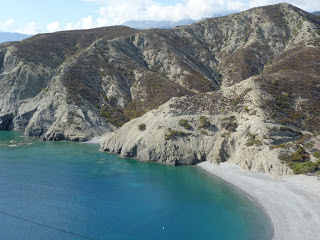
Published on September 30, 2016 11:07
July 18, 2016
At Agios Minas

 18 July
18 JulyI woke up this morning when it got light; went back to sleep for a while, then got up when the sun came up over Ayios Minas chapel on the cliffs. I let Lisa loose and we ran through the fields of olive trees and down to the beach, and jumped in the clear blue sea. Coming back and doing a few little chores around the taverna which we call home this summer, I remembered that the figs were ripe on the tree where I usually hang the laundry, and I reached up to pull a few down and eat them for breakfast. Stamatis’ fishing boat was still in the bay. This summer’s diet is fresh fish, our homemade bread made with Cretan flour, salads made with local goats’ cheese made at the top of the valley, yoghurt with local honey made from Erika flowers.


Mid-morning I drove up to Olympos, up the winding, narrow, bumpy dirt track in the rusty Lada, then along the mountain ridge. As usual, I walked up the alley through the village and exchanged greetings and a few words with everyone – Sophia, Evgenia, Foula, etc. ‘How are you? Running again?!’ they ask. Rigopoula and Yianni say hello and ask if there’s enough water pressure for their garden down in Filios. I get the day’s gossip from Maria and Marina, sitting sewing outside their shops. Then I go and clean one of the rooms at Anemos hotel. The hotel I went to stay at for three days back in late April…

 I’m still on the island of Karpathos. I did leave, but only for a week, to go back to Tilos and collect Lisa and a few things I’d need for the summer. The house with the lemon tree in Megalo Horio is hosting other visitors for a few months. In some ways it feels strange to be away from Tilos, but this place is also beginning to feel like home. There’s a long story in it, but for now instead of writing it here, I’ll continue just living it for now, here at Anemos Sunrise on Agios Minas beach.
I’m still on the island of Karpathos. I did leave, but only for a week, to go back to Tilos and collect Lisa and a few things I’d need for the summer. The house with the lemon tree in Megalo Horio is hosting other visitors for a few months. In some ways it feels strange to be away from Tilos, but this place is also beginning to feel like home. There’s a long story in it, but for now instead of writing it here, I’ll continue just living it for now, here at Anemos Sunrise on Agios Minas beach.

It’s now eight thirty in the evening and there’s a bright white almost-full moon high above a sky of pink and pale blue. A wild wind is blowing through the olive trees and the pines.
Find us on Facebook or TripAdvisor at Taverna Anemos Sunrise :-)
Published on July 18, 2016 11:44
July 1, 2016
The story of how I became lost...
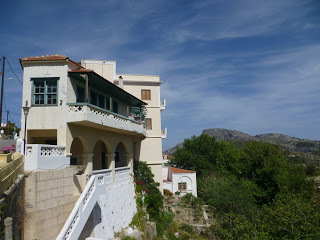
It’s bright and early in the village of Aperi, and the cafes on either side of the bridge are closed. One has been closed for a while and is looking for a new owner. Another should be open soon, says a man who’s taking a break from painting a wall to talk to a handful of men outside the pharmacy. He gives me a koulouri biscuit and says I can keep them company while I wait. The other men say that then he’ll never finish painting the wall.
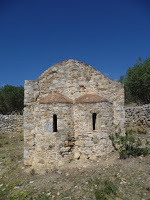
Not wanting to interrupt the redecoration of the Aperi bridge, I ask if the spring water is drinkable and it is, so I fill my bottle, return to the road and start walking. When I made my way up from Ahata beach it was still cool, but it’s warming up. Minas, who has the hotel Anemos which I’ve booked into for three days, has arranged for a friend of his to pick me up on their way to Olympos around 9 a.m. There are few cars, considering this is the main road linking the south of the island with the north; it’s beautiful and peaceful but the hill is tough. I’ve put my heavy backpack down and rested a couple of times when a flatbed truck stops to offer me a lift as far as Spoa. An old man, who introduces himself as Vasilis, gets out and removes a recently slaughtered lamb or goat from the front; it’s just before Easter and several goat-shaped packages were being loaded on the ferry when I left Tilos. He puts it in the back with my backpack beside a pile of leafy branches. Mere minutes after we set off, we crest the hill I’ve been struggling up for the best part of an hour and start gently descending, and I’m mildly disappointed that I didn’t keep walking to the top, especially since I’ve now missed the chance for some stupendous photos of a sheer rock face dotted with pine trees falling away to deep blue sea and a crescent of brilliant white beach. Vasilis tells me it’s Apella.
We chat and he tells me a lot of Karpathos people live in America and Australia and return every summer. As we speed along a winding cliff-edge road with stunning views, he asks if I mind if he stops to feed his animals and something else which I don’t understand. I say of course I don’t mind, hoping it’s something innocuous. We turn off up a dirt track into forest. He tells me to stay in the car as he pulls the branches off the back of the truck and feeds them to the goats, then disappears. When he returns, he puts a covered plastic tub by my feet, and I realise he was milking the goats.

We stop briefly again while he checks his beehives and a few minutes later we’re arriving in Spoa, halfway to Olympos, where he insists on treating me to a coffee at the kafeneio. We sit at a table on the road with a tree for shade, and I notice the name above the door is Koumpanios; it turns out Michalis, the owner, is related to the Koumpanios family in Tilos, the people whose house I rented.A white van is parked outside selling dairy products from the tyrokomeio or cheese factory of Kasos, the neighbouring island. The owner and his daughter sit with us for a while and I buy half a kilo of strong, creamy graviera. They also have butter, dhrilla (a type of cream) and sitaka, a rich, buttery cream which is cooked for over twenty hours – like stakain Crete, but made without flour.


I update Minas at the hotel with my whereabouts so that the friend who’s offered a ride can look out for me; apparently they’ve been delayed. Then I set off along the road again, around the edge of a steep mountain. The sky’s covered with thin cloud but there are lovely views of peaks and old terraces and the sea below. Cars pass from time to time and eventually I give up on the arranged ride and accept one from a very friendly family in a truck. It already looks packed to the gills but Poppy, whose father is driving, insists I will fit and moves around some stuff, and I squeeze into the back seat with her two young girls and a little black dog. They’re from Olympos but usually live in Rhodes, and they’ve taken the Blue Star ferry today to come home for the Easter holidays and open up their restaurant, Milos. I chat and laugh with the two young girls, who practice their English and tell me their village is just around the next corner… Oh no, maybe the next corner… Oh, no, maybe the next! And then, suddenly, there it is: Olympos.
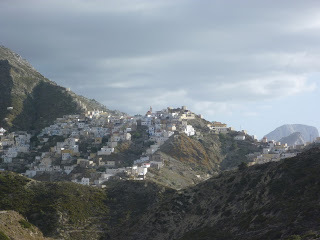
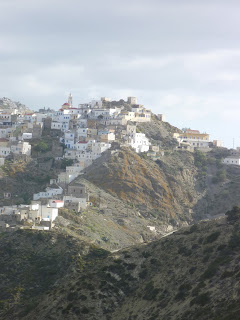
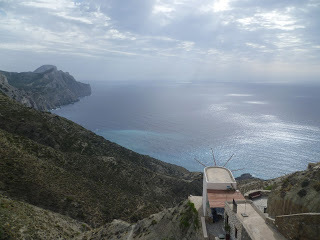


Minas is waiting for me at Sophia’s café by the car park; he invites me to sit down with his cousin for a few minutes and then leads me through the village to my room. There’s a strong wind blowing and an amazing view out over the sea. I check if the water is OK to drink. ‘More than OK.’ The bed is a soufa, a mattress on a raised platform made of carved wood, with cupboard space underneath. It’s lovely.
The last thing I want to do is work, but a project has taken much longer than expected and I have to get online; I take my laptop and go to find a suitable café. A few minutes’ walk along a little alley I first meet Archontoula. She’s a tiny woman, seventy-something, wearing a thick black long-sleeved dress with a colourful apron and a black scarf tied around her head. She’s sitting outside a traditional kafeneion with framed photographs taking up most of the wall space, and simple tables arranged around the sides of the room. After we’ve chatted for a while she invites me in. I apologise and say I need to find somewhere with internet.
‘Den sou leo psemmata,’ she says firmly in a voice built for shouting more than whispering. ‘I won’t lie to you. I don’t have internet.’ I’m not at all surprised and I’m embarrassed that I need it. ‘But you might be able to pick up the community internet from the church. Go inside and try if you like.’
So I sit down in the corner and it works. I order a beer and it comes with a plate of dark green olives, some good bread and a plate of mousmoula, a soft orange-coloured fruit. Archontoula sits in the corner with a bag of wool threads in different colours which she plaits into a string. When I ask her about it, she gives me a necklace with a tassel at the end. You can keep your keys on it, she says. Her headscarf keeps slipping down and she continually has to re-tie it around the top of her head.
A man arrives, tall, hefty and chestnut-skinned with a luxuriant moustache and twinkling eyes. Archontoula introduces her husband, Philippas. She tells him who I am and that she didn’t call me in, I came in of my own accord; it seems an important point. The kafeneio is called Kriti, or Crete, because Philippas’ father lived in Crete for a long time; also because Venizelos was from there.
Eventually I ask if there’s anything more to eat and she gives me bean soup and a tomato and cucumber salad with bread and olives. The price is minimal, and when I protest she says it’s ‘because we got to know one another’. She says I should stay for Easter if I can. I’ll have to look into the boats and connections tomorrow. Her husband says they’ll find me a ride to Pigadia whenever I need to leave.
This is the start of the story of how I became lost in Olympos.


 Next morning, I’m back at Archontoula’s for breakfast, working again at my computer. While I work, she’s trimming artichokes, angenares, ready for cooking and I eat a good hard local cheese with bread and a dollop of thick, flavoursome, opaque honey. People come and go and Archontoula talks with a couple of young men who are doing some work for her on a house. She sounds forceful but fair, and every now and then she erupts into cackling laughter. She tells me that she and her husband pay for the costs of the kafeneio out of their pensions.
Next morning, I’m back at Archontoula’s for breakfast, working again at my computer. While I work, she’s trimming artichokes, angenares, ready for cooking and I eat a good hard local cheese with bread and a dollop of thick, flavoursome, opaque honey. People come and go and Archontoula talks with a couple of young men who are doing some work for her on a house. She sounds forceful but fair, and every now and then she erupts into cackling laughter. She tells me that she and her husband pay for the costs of the kafeneio out of their pensions. A Greek couple arrive, visitors from Patras, and Archontoula gives them a shot of raki. She offers one to me too.
‘I can’t,’ I say, ‘I’m working.’
‘Just one!’ she says.
When I leave around lunchtime, it’s suddenly so windy I can hardly stand up. The supermarket is closed, but someone tells me the lady who owns it has just gone across the street to the pharmacy, so I wait and sure enough she opens up again, so I buy coffee and a notebook and toothpaste. As I leave, a man’s hat blows off and we laugh. He asks me if I arrived on foot yesterday – he saw me as he went past. He says if I want a ride I need to do ‘auto-stop’, otherwise people think you prefer to walk.
That afternoon, sitting in Parthenon café surrounded by more old photographs, I finish the piece of work that has gone on and on. Then I go for a walk. I’m sure it’s partly relief at finishing that project, but I’m practically in tears as I walk around Olympos village, out to its edges on the mountains and down into the valley.
The physical setting, with the sheer mountains rising up, and the way houses and windmills cling to the slopes and ridges. Can there be a more beautiful place? Sometimes it reminds me of Santorini (but before it was discovered); sometimes I feel I’m in the Himalayas or Machu Picchu. Everywhere I turn, there is something surprising and spectacular. The colours of the stone itself – green, brown and white – and the houses – white, blue, yellow – and the way they are decorated. The terraces with olives and figs and vines; from across the valley I looked back to the village and saw a boy leading a goat by a rope; a woman in black picking fruit from a tree; another sitting in a field with her goats. And I love the beautiful dress of the women, black with bright embroidery, black headscarves and high leather boots; and the way they smile. The angles of the steps, the sun setting into the sea.
Arriving back in the room I glimpse myself in the mirror looking rosy-cheeked and windswept. I crawl into my very comfy bed on its raised wooden platform with a window out to the sea, and fall happily asleep for a while. When I wake, relaxed, it’s evening and I hear the church bell close by. The big church is lit up for the service, and inside are old frescoes and gilded wood and huge, brilliant chandeliers, the sound of chanting and the smell of incense.
Archontoula heats up artichokes and potatoes for me, the food I watched her prepare in the morning; with herbs and olive oil in tomato sauce with that hard, white, salty local cheese, and olives and bread and a glass of cold water. There’s no fuss; it’s all just done simply and beautifully.
I’m so happy to be here.




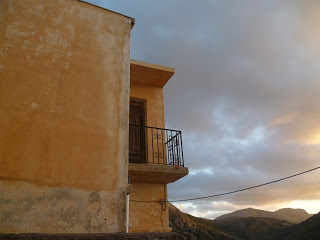

Published on July 01, 2016 11:22
June 13, 2016
On the Way to Olympos

‘Karpathos! Olympos! Oreia! Den echo paei, alla…’ I was hearing this a lot. Everyone said Olympos was beautiful but no-one had been.
It required quite a commitment to get there from Tilos. Although I could see Karpathos on the horizon from Megalo Horio, it meant juggling ferry or flight connections, stopover days in Rhodes or Halki. The port of Diafani in north Karpathos, which serviced Olympos, was damaged so I’d have to disembark in the southern port of Pigadia and make my way north by land. Buses only ran twice a week; it was too early for excursion boats; taxis cost an arm and a leg for the hour-long drive. Renting a car seemed an expensive solution. Maybe I wouldn’t make it to Olympos after all… Yet the film and still images I’d seen of the remote village high on a mountain looked stunning.
I decided to go the week before Easter when I had a pet-sitter for Lisa who was happy to stay as long as I needed. Olympos was said to have retained many traditions and I wanted to arrive before the Easter celebrations to witness everyday life.
‘Olympos,’ said one shop owner during my weekend stopover in Rhodes, where I interspersed work with shopping and seeing friends. ‘I have clients from there – interesting customers.’
‘What d’you mean?’ I asked, laughing.
‘You’ll see. Come back and tell me when you return.’
That evening I went to Mikro Kafe on Pythagoras, down the road from Kristina’s Rooms where I had a lovely place for a couple of nights. Dimitris, with sharp-cut hair and a tailored shirt, came from the north of Greece and studied old coins but had started working as a bartender since he wasn’t making money selling antiques. Yiannis bought me a drink and they both confirmed that Olympos was the place to go in Karpathos. Manolis then joined us and said they made leather boots in Olympos and the women were in charge of the money. I said I might stay there for Easter, or might not.
‘Karpatho!’ said Dimitris, shaking his head. ‘Fai-nono, fai-nono.’ Food-sleep, food-sleep. Nothing else. ‘You’ll come back fat!’ He stuck out his elbows to suggest how fat I was going to get with all that food and sleep. Then he made me a white rose out of a napkin, but Yiannis screwed it up jealously, so Dimitris bought me a real one and Yiannis bought some more drinks while Dimitris cooked me a feast of sausages and eggs. ‘You must come back to Rhodes for Easter. An den ertheis, tha ginei hamos.’And so around 2 a.m. in late April, full of good food and wine and with a big smile on my face from the company of all the new friends I’d made in Rhodes, I went back to Kristina’s Rooms for my backpack, then walked past Mikro Kafe and waved, continued past crowds standing outside bars where music was playing. I thought how happy I was to have come to live in Greece. What a life. I walked down to the port to wait for the ferry, the Preveli.
 It’s a bright, sunny morning and on the big old ship Preveli, sleeping bodies are randomly laid out like the aftermath of an accident. The engine thrums as we pass down the coast of a magical-looking island. Karpathos, from here, seems to be one long and impenetrable mountain ridge. It looks like something created for a film like Lord of the Rings using special effects.Although most Greek people I’ve spoken to about northern Karpathos say ‘Ah, it’s beautiful! But I’ve never been’ – as if it’s some distant realm instead of just a hop from Rhodes – my English friend and my Australian friend brought me back to earth by saying, ‘Ah, I wonder if it’s as good as it was when I was there twenty years ago?’ Marc Dubin in the Rough Guide grumbled years ago that it was no longer the place it had been. I wonder how I will find it?
It’s a bright, sunny morning and on the big old ship Preveli, sleeping bodies are randomly laid out like the aftermath of an accident. The engine thrums as we pass down the coast of a magical-looking island. Karpathos, from here, seems to be one long and impenetrable mountain ridge. It looks like something created for a film like Lord of the Rings using special effects.Although most Greek people I’ve spoken to about northern Karpathos say ‘Ah, it’s beautiful! But I’ve never been’ – as if it’s some distant realm instead of just a hop from Rhodes – my English friend and my Australian friend brought me back to earth by saying, ‘Ah, I wonder if it’s as good as it was when I was there twenty years ago?’ Marc Dubin in the Rough Guide grumbled years ago that it was no longer the place it had been. I wonder how I will find it?The other foreigners I met on the dock in Rhodes in the middle of the night waiting for the Preveli were continuing to Crete: an intrepid old Scottish couple and a very talkative young Latvian, on his way to work at a resort for the summer, who was sorely disappointed when I said I wasn’t joining him at the bar but going to get a few hours’ kip. When I asked the crew, as I boarded, what time we’d arrive in Karpathos, they looked panicked and said, ‘Depends what time we leave here!’ Crowds were pushing up the gangway as massive trucks drove off. I found a spot for my camping mat (not under the stars but under the stairs) and slept well.There’s no other land in sight, just that long ridge with a road cut into it and the occasional village gleaming white, up high. It seems like a long, straightened out Santorini. As we close in on the south of the island it’s clear how rugged it is. It seems all beaches and mountains: my kind of place.
We enter the harbour.


I previously saw Pigadia when I travelled back from Crete on the Preveli, and was bemused by the density of low-rise apartment buildings; today the bay is a brilliant blue and the water invitingly clear, but this isn’t the Karpathos I came to see. I take a card from a taxi driver in case I need one. I find out the next bus to Olympos isn’t for three days and I realise I haven’t brought my driving licence even if I did change my mind about a car. I’m too happy to be concerned by any of this, though. I’m on an adventure, and the sun is shining. I call Minas, the man I’ve booked a room with in Olympos - surprised to hear an American accent - and explain I’ll just get there when I can, hoping I can shift my booking; he says to check at the supermarket in case anyone is driving up but they shrug and say they don’t know of anyone going up this morning. While there I ask half-jokingly about walking to Olympos over a few days and a woman says that’s definitely not possible. I have a feeling she doesn’t really know, though, she’s just guessing. There’s a bookshop selling maps but it’s Sunday and it’s closed, so I copy a basic map from the wall of a car rental shop into my notebook. Then I set off walking, to see what happens. After a swim off a sandy beach, I head out of town on foot.


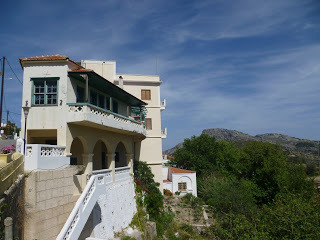
I leave my backpack at the gates of a church at the bottom of the village of Aperi. I’ve been hiking uphill for several kilometres in the warm sun. Aperi seems a prosperous modern village surrounded by well-kept chapels and fields, and I ask a woman beside a gleaming new car if there’s a shop. She directs me to the taverna by the bridge, To Gefiri, where an older man makes me a gigantic pita gyros filled with meat and chips and tzatziki and salad; in fact, he makes me two, one of them to take away for later. There are no rooms to rent in the village, so I ask about camping on Ahata beach, and he doesn’t think it will be a problem. Another man comes over to chat, Nikitas, and when I tell him I live in Tilos he says, ‘Say hello to the owner of the Spanos ferry and squeeze his cheek from me.’




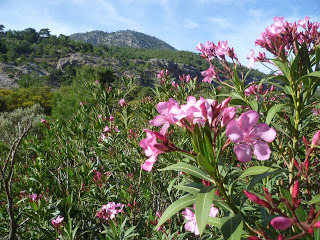
It seems perverse to be walking all the way downhill again several kilometres to a beach, but thankfully the scenery in the rocky, green, pine-filled valley is glorious, reminding me of the gorges of southwest Crete, and I have it to myself. My backpack is digging into my shoulders, so I offload a carrier bag of non-essentials (wishing I’d had less time for shopping in Rhodes) and leave them hanging in a tree to pick up on my way back tomorrow. The road seems to go on forever but finally the beach appears and it is a heavenly white-pebbled cove.

I set up the tent which Edward gave me and have a good swim. Then I turn on my phone and send a message to Minas, saying ‘Am camping on Ahata beach for the night.’ He calls in response and I half-expect him to tell me it’s not allowed, but instead he says, ‘It’s a clear night and should be beautiful, lots of stars…’ He’s also arranged for someone to pick me up at the road tomorrow and drive me to Olympos to stay at his hotel.It is a beautiful night. With waves lapping a few metres away, I can’t help falling asleep in the early evening, awakening a couple of hours later to moonlight and stars and a fishing boat coming into the cove. I sleep again, and wake to a gale-force wind whooshing through the pine trees and doing its best to blow the tent over.
Shivering, I stuff everything into my backpack and then carry the empty tent, now flapping around and trying to take off, into a more sheltered spot in the lee of the cliffs. It’s less picturesque, next to an old caravan with its windows broken, but the tent feels less vulnerable. I put on as many clothes as I can, snuggle back into my sleeping bag and sleep until morning.
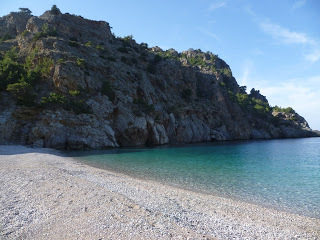

Published on June 13, 2016 05:56
June 1, 2016
Sea Captains, Sea Bream and Swimming in Lovely Lindos

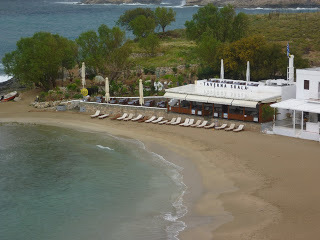
On my first afternoon in Lindos, I’d arranged to meet Karen and Claire from Exclusively Lindos at the relaxed Skala taverna on the edge of the sandy beach. Looking out across the little bay, we spent the afternoon laughing and swapping stories over a superb lunch that included fried calamari and tzatziki and a Greek salad with capers, plus three excellent cooked dishes: a spicy sausage dish called spetsofai, aubergine in rich tomato sauce, baked in the oven and topped with cheese, and one of my favourites, peas cooked with potatoes, carrots and herbs in olive oil.
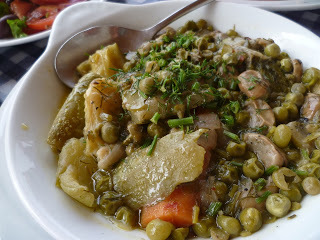 As the afternoon wore on we made our way through this feast and drank wine and the sun gleamed on the bay. We thanked chef Giorgos and the team at Skala, sending greetings to owner Sotiris who was working on his new restaurant in Lardos. I waved goodbye to my new friends for now and couldn’t resist slipping into the sea that lapped at the shore. As I swam, a light spring rain began to fall and the soft sunlight that emerged through the clouds afterwards was beautiful.
As the afternoon wore on we made our way through this feast and drank wine and the sun gleamed on the bay. We thanked chef Giorgos and the team at Skala, sending greetings to owner Sotiris who was working on his new restaurant in Lardos. I waved goodbye to my new friends for now and couldn’t resist slipping into the sea that lapped at the shore. As I swam, a light spring rain began to fall and the soft sunlight that emerged through the clouds afterwards was beautiful.




Just as New York isn’t really America, Lindos isn’t really Rhodes; it’s got a charm and magic all of its own. The village and its immediate surroundings have been protected from development because of the archaeological significance: it was a major trading and shipping centre as far back as the 8th century BC, pre-dating Rhodes town and sending a contingent of ships to the Trojan War. The Acropolis of Lindos with its temple of Athena may be older than the one in Athens, overlooking St Paul’s bay where the Apostle took shelter from a storm; the fortress around it was built by the medieval Knights of St John. The buildings are all in traditional ‘sugar-cube’ style and contained within the old village limits. Built around the edges of a hill with ancient ruins atop it and the sea on three sides, from the 1960s it attracted artistic types from all over the world.

 I first stayed in a villa in Lindos in the 1980s with my family; a few years ago I returned in midsummer and sampled the restaurants and bars with my friend Hari. This time, Exclusively Lindos had offered me a stay in a ‘Captain’s House’ in the heart of Lindos for a few days in April. It would be a quiet time, I expected, since the season doesn’t really start until 1 May; and Lindos looked very pretty, the surroundings tinged with green.
I first stayed in a villa in Lindos in the 1980s with my family; a few years ago I returned in midsummer and sampled the restaurants and bars with my friend Hari. This time, Exclusively Lindos had offered me a stay in a ‘Captain’s House’ in the heart of Lindos for a few days in April. It would be a quiet time, I expected, since the season doesn’t really start until 1 May; and Lindos looked very pretty, the surroundings tinged with green.
 The Captain’s Houses were the homes of the affluent merchant seamen of Lindos in the 16th and 17th centuries. Hidden behind high walls and grand doorways, they housed sizeable families and were decorated with Byzantine and Arabesque features and pebble mosaic courtyards. On my previous visit I’d seen the Papakonstandis Mansion. The Captain’s House accommodation offered through Exclusively Lindos is owned by a local family who handcrafted the interior woodwork. Off the courtyard are two bedrooms, a kitchen and the tall, magnificent sala, with its painted wooden ceiling and traditional raised platforms for sleeping and relaxing. To stay in such a place, part of the heart and history of the village, was very special.
The Captain’s Houses were the homes of the affluent merchant seamen of Lindos in the 16th and 17th centuries. Hidden behind high walls and grand doorways, they housed sizeable families and were decorated with Byzantine and Arabesque features and pebble mosaic courtyards. On my previous visit I’d seen the Papakonstandis Mansion. The Captain’s House accommodation offered through Exclusively Lindos is owned by a local family who handcrafted the interior woodwork. Off the courtyard are two bedrooms, a kitchen and the tall, magnificent sala, with its painted wooden ceiling and traditional raised platforms for sleeping and relaxing. To stay in such a place, part of the heart and history of the village, was very special.


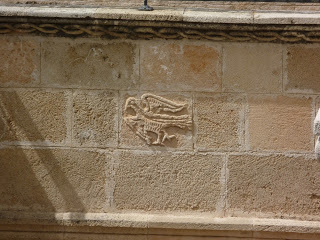
The next morning I had Ayios Pavlos (Saint Paul’s) Bay to myself for a morning swim.

My mum was flying over to join me at the Captain’s House so we would make the most of the few days. When she arrived, we went straight down to the bay for lunch at Tambakio, a stylish restaurant on the water’s edge. The tambakio was a tannery (‘tambak’ being the Turkish word for leather, apparently); they would slaughter the sheep or goats there and it had been used until World War Two; then converted into a restaurant thirty years ago, and owned by the same man who has two of the most popular summer clubs in Lindos, Antika in the village and Amphitheatro up on the hill. We ate tsipoura, a type of bream which was grilled and tasted delicious with salad and wine.


Later, we were invited to join a wedding reception at Yannis’ bar, and after dinner at Symposio – where we ate excellent lamb kleftiko (and Joanna, the chef, recognised me from my appearance on the Tilos episode of 60 Lepta Ellada!) – we were invited by new friends Giannis and Michalis for drinks and dancing at Socrates Bar, which usually has rock music except for Saturday nights when they play Greek music. It was a warm welcome to Lindos and by the early hours, it seemed it wouldn’t be such a quiet few days after all.
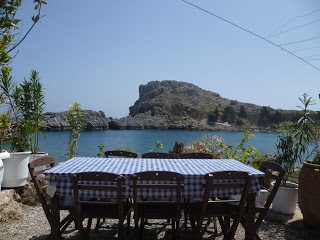
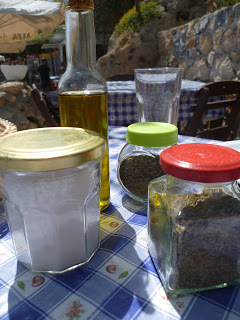
After a late start next day, we spent the day lazing on loungers and swimming across St Paul’s Bay and had lunch this time at the opposite side, the ‘kantina’, where the tiered patches of land around were planted with vegetables and herbs, and the olive oil, coarse salt and oregano were all local. It was another beautiful setting. In the evening as we availed ourselves of the internet connection over a lovely glass of wine at Giorgios’ bar, Joanna, the chef from Symposio, came by to offer us some of her home-made, delicious chocolates. We ate dinner at Calypso: another bream, this time with horta and dolmades. After a few intense days of walking in Embona, I was making up for it with plenty of dinners and drinks...On Monday morning, I sauntered around the village just as little kids were walking to school, and bread was being delivered, hanging in plastic bags from door handles. Like the donkeys grazing in the car park, it was a nice reminder that in spite of the style and glamour, Lindos is also a simple Greek village. Once again, I had St Paul’s Bay to myself. In spite of a cool spring breeze and some clouds, the sun was warm and the sea beautifully clear.

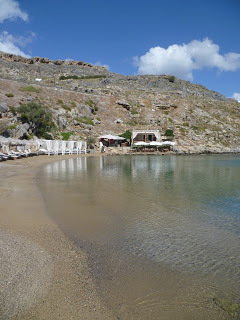
The weather turned rainy again in the afternoon, but Mum and I felt like stretching our legs so we walked around the coast towards Pefkos, up to the little church of Profitis Ilias and then to the thirteenth-century monastery of Ayios Giannis Meroglitis.



It gave us an excuse to live large again in the evening, with a return visit to Symposio for a wonderful dinner: olives crushed with lemon; succulent kalamari fried whole; bread with tapenade and taramasalata; a salad of lettuce, rocket, tomato, cucumber, pomegranate, avocado and honey-roasted walnuts; a sea bream with a very light lemon-herb sauce; and fresh potatoes with sea salt. We’d had three days of sheer enjoyment in lovely surroundings, eating and drinking, swimming and dancing, with a peaceful Captain’s House to call home, and new friends to visit again.
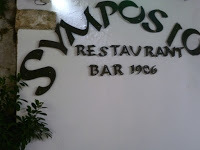

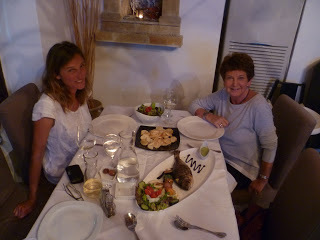
Published on June 01, 2016 06:24
May 13, 2016
A Walking Holiday in Embona, Rhodes
 In early April, I had three days in the traditional mountain village of Embona. The weather was warm but not too warm. The flowers were all out and spring was at its best, and yet there was no-one around. I would spend my afternoons walking around Embona.
In early April, I had three days in the traditional mountain village of Embona. The weather was warm but not too warm. The flowers were all out and spring was at its best, and yet there was no-one around. I would spend my afternoons walking around Embona.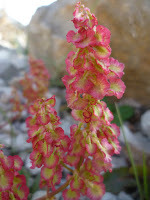

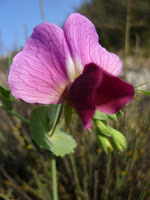
Attaviros
Attaviros (or Atavyros) mountain is 1,215 metres, the highest peak on the island of Rhodes. I didn’t have a map, but in the Attaviros Hotel they said it was easy to find the way up. I’d scouted out the first section the evening before, up a semi-paved road that twisted and turned amid tiny vineyards and wildflowers to a gate. I noticed quite a few shells from hunting rifles; in Tilos there’s a hunting ban, but here the hunting of hare and partridge and smaller birds was allowed in certain seasons.
Having found a blog with directions, I set out around midday with cheese and halva, oranges and tomatoes and paximadia in my backpack. I followed the path over an iron ladder straddling a fence. From there, it was pretty much a question of following a shingle gulley with a steep gradient up the mountain.

Stopping for a rest in the shade of a tree, I looked down to see red earth and vineyards; then a patchwork of pine forest and olive groves from Embona to Kritinias Castle on the coast, then all the little islands towards Halki; there was a clear view of the port at Halki and the road winding up from it; and I could make out the steep triangle at the south end of Tilos, and beyond that Profitis Ilias.Higher, the path began to level out and the terrain became lush with grass and flowers. Sitting on a rock ledge, I could still hear the kids playing in the school in Embona; but could also hear so many birds, see hawks gliding overhead and goats scrambling over the rocks. The view was panoramic along the northwest coast of the island.

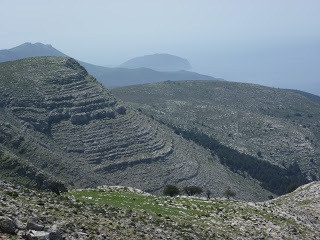
Further on and up, the smooth, flat tops of the mountain peak were green, pasture-like, dotted with trees; then they fell away in layers of rock. Embona disappeared from sight and sound, too far below the steep mountainside. It was still and peaceful, just birds and buzzing insects. It had taken two and a half hours, with lots of stops to enjoy the views. I walked around the empty crown of the mountain to find the massively impressive ancient site of the temple of Zeus. Most beautiful of all to me was the view to the south – the mountain falling away into smooth ridges and a river valley, green and grey with grass and rocks and the dark green of the trees, and the musical clattering of the sheep’s bells.




A lovely footpath descends gently from here to Ayios Isidoros. I followed it for a little while, then joined the dirt track road that wound down the mountain – a long way home, but easier than the near-vertical shingle gully and it took me towards the coast as the sun was descending.


When a truck drove past I realised I’d seen no-one else the whole afternoon on the mountain. Another truck drew up as I was leaving the pine forest and an old farmer offered me a lift; I was completely exhausted but it was only another five or so kilometres back to Embona, and a lovely evening, so I chose to continue walking, making a final stop at the little chapel of Ayios Georgios Sarantari and feeling very happy about my adventure.

Kameiros Skala, Kopria Beach and Kritinia
I passed a very old woman doing her washing by hand in a sink in her front yard around 7am. I wandered around the village looking for a place with internet, and ended up at Anamnisis café, which looked fancy from outside but was nicely full of middle-aged men loudly discussing the price they get for their wine. Picking up a traditional spinach pie from the bakery, I looked up at the steep, rocky mountain which bellied out into an inverse amphitheatre of rich soil divided into fields above the village. The people of Embona and Kritinias came originally from Kriti, or Crete. Maybe that’s why they picked a place with the pastures on the high mountain, fertile highland plains.‘Is it possible to walk to the sea?’ I asked at the hotel. They said yes, it wasn’t far, directing me to start from between the sports ground and the cemetery. From there, beyond some ambiguous signage, a well-marked, wide track meandered gently down through pine forest. It was a little dull but easy walking for an hour or so, luckily as my legs were still a little weary from the day before. At what I reckoned must be the dam, the fragma, though it was dry and looked like a quarry, were piles of thin branches with string attached - trimmed vines, I realised. The path met the road and I turned left past farms along the coast.

Around 2pm, less than an hour and a half from Embona, I reached Kameiros Skala where vehicles were making their way to the Nissos Halki ferry, which sat beside small wooden fishing boats. The water in the tiny, pretty harbour was blue and clear, and I thought how nice it would be another time to travel from Tilos to Halki and then on to here, and up to Embona. A triangular carving in the cliff and a few cave-like hollows I recognised as the ancient Lycian tomb, similar to the one in Kastellorizo. There was a bus back to Embona leaving soon but I hadn’t yet had a swim. Just around the headland I was back at pretty Kopria beach, busier today. After an invigorating dip and a refreshing nap on the sand, I headed out, weighing the pros and cons of taking the same route back or risking a longer but more interesting alternative. Naturally opting for the latter – because one thing I’ve realised about myself is that I’d rather get a few scratches and scrapes than be bored – I wandered on and off the road for a little while, enjoying the late afternoon spring sunshine, a glorious view of the medieval Kritinias Castle perched on a rock overlooking the sea, the fields around all lush and green and lovely.

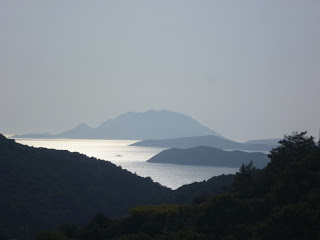
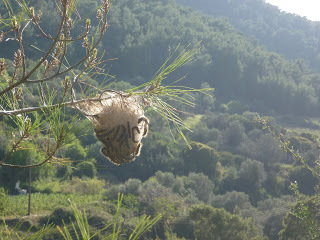
At the entrance to the village of Kritinias, a sign said Embona was 8km straight ahead. There wasn’t any particular reason to detour to Kritinias, but it seemed a shame to pass right by without taking a look. Maybe I’d get a frappe for energy. A dog lounged in front of a mechanic’s garage. Past a run-down square with an abandoned house was a café where a group of men and one woman were sitting. I shouted out ‘Yeia sas!’ and people waved and invited me over.
 Well, I can’t now remember all the things we talked about but suffice it to say, I was welcomed like a long-lost friend. I was given tiny local calamari and fried cod, tomato with sea salt and bread, and a couple of glasses of home-made wine. We laughed and chatted. The lady who ran the taverna (‘Spyros’) gave me a swift lesson in preparing thick stalks of caper leaves for salad, which she first soaked in hot water from the tap overnight, pressing the capers down with a bowl to keep them underwater, before changing to cold water for another day, and then adding one dessertspoon of salt per litre jar of water for preserving them, with a touch of vinegar. Someone gave me a slice of lemon to eat, dipped in sea salt – wonderful.
Well, I can’t now remember all the things we talked about but suffice it to say, I was welcomed like a long-lost friend. I was given tiny local calamari and fried cod, tomato with sea salt and bread, and a couple of glasses of home-made wine. We laughed and chatted. The lady who ran the taverna (‘Spyros’) gave me a swift lesson in preparing thick stalks of caper leaves for salad, which she first soaked in hot water from the tap overnight, pressing the capers down with a bowl to keep them underwater, before changing to cold water for another day, and then adding one dessertspoon of salt per litre jar of water for preserving them, with a touch of vinegar. Someone gave me a slice of lemon to eat, dipped in sea salt – wonderful. 


The people were proud of their village and I thought again how sociable this country is and how much people care about the good things in life – meeting people and eating good, natural, local food.When eventually I forced myself back onto the road, all payment was refused. And about a kilometre up the road, a truck pulled up and there was one of the guys, offering to drive me to Embona.
Around Embona
It was funny to be back in Embona seeing people I recognised from my visit a few years before, people I’d written about. I wished I had a copy of An Octopus in my Ouzo to show them. The next morning at the café, the owner – a big man wearing the biggest T-shirt I’d ever seen – asked about my work, and we discussed his interest in collecting books about beekeeping and honey in different regions. Here in Embona, I think he said, each bee can produce 25 kilos of honey per season.The friendly old ladies in the tiny house next to the hotel were always busy; this morning the white-haired lady was cleaning and had sat some just-washed teddy bears on the front wall to dry, which looked rather surreal. Swallows had built a nest above the light fixture at the electrical goods shop, and flocks of swallows or martens swooped at the edges of the village. Lovely light spilled over the mountain as morning progressed. The group of cyclists staying at the hotel were getting ready to set out.I was due in Lindos the next day and although some mad idea of walking and hitch-hiking there had entered my head, I had work to do in the morning that prevented such an epic adventure; I’d wander around the side of Attavyros instead. I enjoyed taking photos of all the different flowers, wandering along tracks through the fields; bees were going crazy on the sage flowers.


I stopped at St Raphael and Nicholas church, whose unpromising exterior gave away nothing of the beautiful icon paintings within. Then, having reached a dead end at a fence, I cut through an overgrown area and – whoops – twisted my ankle a little. It didn’t seem serious but it did swell a little and there was a jarring pain when I put weight on it in a certain way. A sign to take it easy. I made my way carefully down to the road.Two men by a truck shouted hello and we exchanged a few friendly words. ‘These are our sheep,’ one man said, indicating a flock under the trees. ‘Come back at Easter and we’ll make a barbecue!’
 I loved watching the mountain change colour and shape as I walked along the road around it, passed only very occasionally by a pickup truck. I loved the smell of pine trees in the hot sun, and the clattering bells and complaining noises of the sheep as they noisily gathered in the valley below. I sometimes saw an eagle above, or hoopoes, and some big lizards. I’d come back another time and walk to Ayios Isidoros from Embona, maybe then all the way down the spine of south Rhodes to Prasonisi… For now, I turned back, resting for a while in the shade of a pergola over a spring, or sitting on a bed of pine needles, listening to the sound of the wind whooshing wave-like through the forest, building up and then dying off.I reached the truck I’d passed earlier, but no sign of the two men, even though the radio was playing music. Then I looked into the olive grove and saw them sitting in the shade at a little table laid out with food and glasses. They beckoned me over, and thus I got to know Philippas and Christotomos. I sat on the earth by the roots of a tree and they poured me souma and gave me cheese and cucumber and salt to go with it, and I laughed at the wonderful scene.
I loved watching the mountain change colour and shape as I walked along the road around it, passed only very occasionally by a pickup truck. I loved the smell of pine trees in the hot sun, and the clattering bells and complaining noises of the sheep as they noisily gathered in the valley below. I sometimes saw an eagle above, or hoopoes, and some big lizards. I’d come back another time and walk to Ayios Isidoros from Embona, maybe then all the way down the spine of south Rhodes to Prasonisi… For now, I turned back, resting for a while in the shade of a pergola over a spring, or sitting on a bed of pine needles, listening to the sound of the wind whooshing wave-like through the forest, building up and then dying off.I reached the truck I’d passed earlier, but no sign of the two men, even though the radio was playing music. Then I looked into the olive grove and saw them sitting in the shade at a little table laid out with food and glasses. They beckoned me over, and thus I got to know Philippas and Christotomos. I sat on the earth by the roots of a tree and they poured me souma and gave me cheese and cucumber and salt to go with it, and I laughed at the wonderful scene.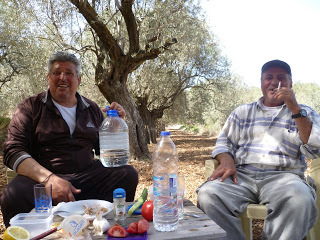
‘They can’t take this away from us – not even Merkel!’Philippas, the owner of the sheep and the olive trees, had left Embona to work with metals in Belgium and Austria; when he left around 1967, Embona had no electricity so he was amazed to see electric lights – ‘Not just in the house, but on the road!’ And he’d never seen a train before. But eventually he returned to Greece, for the good life, where you sit in an olive grove in the sunshine and wait for friends to stop by. At first he’d got a few sheep just to graze and keep the fields clear of grass, but when the flock grew he started to keep them professionally. He was zealous about getting a fair price for Embona lamb, and had even tried to set up a co-operative at one point. He was against the supermarkets taking too much, when it’s the farmers who have to be up on the mountain in the middle of the night if it’s freezing cold or it there are hunting dogs about that can kill baby lambs. Christotomos, or Tommy, wore a brown tracksuit and traffic-cop shades. He was convinced I must smoke drugs because I seemed so happy. ‘A little wine’s enough for me,’ I said. ‘Ah, as the song goes: Wine, moonlight, and my boy…’ Eventually he got a call and had to leave, and we heard him say, ‘I’m busy, working…’ I stayed with Philippas and asked him if it was true that the EU had paid farmers to pull up their vines. He confirmed they had, four years ago, and that it seemed a pretty dirty thing to do during the economic crisis. People should have known there was something rotten about being offered money to do nothing, but many of the farmers were uneducated and simply took the offer. But a few families, whose children had been to school until the age of eighteen, had refused and were now doing well.There was work for local people at the big hotels, he said; but he knew a couple who had worked all season and neither of them got paid. It reminded me of someone I know who worked for six months on new construction in Rhodes and didn’t get paid either. Times were tough; last time Philippas went to Rhodes town, he saw a friend who invited him for coffee at his home (instead of a café) and then sent his wife next door to borrow the coffee. In some parts of Rhodes, the local councils give out basic provisions to the poor families. At least in a village, one person might have potatoes that they’ll give to another in return for some goat, and so on.Philippas’ grandson came by, and then another sheep farmer who wanted to discuss the prices for the animals they’d slaughter for Easter. Ilias had a village accent and lived up on the mountain and kept a pig and chickens too, and picked at food using the tip of his pen-knife, which he then stuck in the wooden table when he left for a while to feed his animals. After sitting for a couple of hours, I continued back to Embona, thinking I should buy some honey from the café-owner. As I approached Anamnisis, the café seemed closed and he was occupied with unloading something from his truck, so I walked by. Then a girl ran after me and said her father was asking me to come and taste the honey.


They’d collected honeycomb and gave me pieces to eat. Stavros showed me and his daughter the eggs; the queen can lay 2,500 a day in spring when there’s a lot of food, he said. We tasted the pale honey, made from a variety of spring flowers, and the powdery orange yiri. I asked about the darker pine honey and learned that the white foamy substance I’d been seeing on the bark of pine trees is a kind of bacterium, and the droplets hanging from it a type of honey. I’d learned so much today. I bought a kilo of mixed pine and thyme honey, strong and fragrant, which Stavros gave me for a very good price, instructing his daughter to pack a box of honeycomb for me as a gift.At a little café next to the petrol station, I enjoyed the last of the early evening light and received an email from Karen at Exclusively Lindos about lunch the next day. I would be heading to a different part of Rhodes in the morning. I paid a euro fifty for my coffee which seemed a little expensive compared to the other café and I laughed, thinking of the guys in the field earlier saying when they went to Rhodes town and were charged three euros for a coffee, it stuck in the throat, wouldn’t go down… For days I’d just had picnic meals but I wanted to try Maroullakis Taverna in the middle of the village; it had seemed fairly busy every night, and I was feeling a little down about leaving Embona. I ate very fresh salad with creamy feta and good bread, and a mix of meat and cheese fritters, with some semi-sweet red wine; locals tend to prefer it to dry, and it’s growing on me. The tyrokeftedes or cheese fritters were like spongy little doughnuts with melted cheese inside, and the others were very meaty and full of herbs – delicious. Suddenly a man with a wild Afro-style hairdo and a denim shirt half-open banged on the door and made a grand entrance, carrying a bag of broad beans, which he distributed to all the tables before sitting down to tell a story about catching an eel. When I went to pay, I got into conversation with the proprietress, Irini (the restaurant had been in her family for 95 years), who gave me cakes for my bus journey in the morning.
The sun was coming up through cloud over Embona as I made my way north by bus along the coast. By midday, I'd be in Lindos and had another adventure to come.
Attaviros Hotel, Embona, Rhodes: 0030 22460 41235, 0030 694 262 9556
Proprietress: Vassilia Antonaki
www.ataviroshotel.gr
Maroullakis Traditional Taverna, Embona, Rhodes: 0030 22460 41215, 0030 694 820 1220
Published on May 13, 2016 02:37
May 2, 2016
The Rhodes Road Trip
 At the start of April, after two days at Nikos Takis Hotel in the Old Town, Yiannis and I had another two days to drive around the biggest island in the Dodecanese – from Rhodes town at the northeast tip, down the coast road to Prasonisi at the southwest end, and back again around the other side with a detour into the mountains.
At the start of April, after two days at Nikos Takis Hotel in the Old Town, Yiannis and I had another two days to drive around the biggest island in the Dodecanese – from Rhodes town at the northeast tip, down the coast road to Prasonisi at the southwest end, and back again around the other side with a detour into the mountains.Rhodes to TsambikaTwenty minutes’ drive south on the Lindos Road is Tsambika monastery perched high on a hill, where women would traditionally climb barefoot to the little church to pray to the Virgin Mary for a child – and then name the resulting child Tsampikos or Tsampika. It’s better known these days for the long sandy beach below, which gets packed in summer. But we turned off the main road to find it utterly quiet, just goats and cats, one shop just opening. It was a sunny but hazy, warm morning and we had swam far out in the pale blue water, looking up at the cliffs and down at the ripples of sand on the sea bed.

Lindos to Prasonisi
 We stopped to look out over the white village of Lindos with its acropolis and castle on a hill still green from winter. I’d be coming back here on my own later for a few days, so we continued. The road was quiet. We sped past Lardos with its huge hotel complexes (not my favourite thing) and then a stretch of coast with a mish-mash of architectural villas, and down into South Rhodes, an area I had never explored. The landscape began to show a more rugged beauty – windswept fields, wild beach – and became hillier approaching Kattavia, pretty with green fields and endless spring flowers. We crested the final hill.
We stopped to look out over the white village of Lindos with its acropolis and castle on a hill still green from winter. I’d be coming back here on my own later for a few days, so we continued. The road was quiet. We sped past Lardos with its huge hotel complexes (not my favourite thing) and then a stretch of coast with a mish-mash of architectural villas, and down into South Rhodes, an area I had never explored. The landscape began to show a more rugged beauty – windswept fields, wild beach – and became hillier approaching Kattavia, pretty with green fields and endless spring flowers. We crested the final hill.
 Prasonisi is a tiny island attached to the southern tip of Rhodes by an hourglass-shaped stretch of sand. It’s a popular windsurfing site in summer, a ‘Natura Park’ conservation area with just a tight little enclave of rooms and restaurants. Strange, then, that as we drove down towards it we passed the construction site for a new power station for Rhodes. Poor Prasonisi. Those who protested building it here with their ‘Save Prasonisi’ campaign had placed a sign down on the sand, but construction seemed well under way.The beach didn’t look at its best either. Beaches bear the brunt of our pollution of the seas with plastic and local residents work hard to clear away the rubbish that washes up during winter so that beaches look beautiful in summer. A young British couple who arrived in a rental car looked shocked by the sobering state of the sand, and a couple of weeks later I’d meet an Australian couple who reacted the same way. What a gateway to Prasonisi.
Prasonisi is a tiny island attached to the southern tip of Rhodes by an hourglass-shaped stretch of sand. It’s a popular windsurfing site in summer, a ‘Natura Park’ conservation area with just a tight little enclave of rooms and restaurants. Strange, then, that as we drove down towards it we passed the construction site for a new power station for Rhodes. Poor Prasonisi. Those who protested building it here with their ‘Save Prasonisi’ campaign had placed a sign down on the sand, but construction seemed well under way.The beach didn’t look at its best either. Beaches bear the brunt of our pollution of the seas with plastic and local residents work hard to clear away the rubbish that washes up during winter so that beaches look beautiful in summer. A young British couple who arrived in a rental car looked shocked by the sobering state of the sand, and a couple of weeks later I’d meet an Australian couple who reacted the same way. What a gateway to Prasonisi.
 Across the sand the island itself, however, with its gentle hills sweeping down to the sea somehow retained an untouched beauty, a feeling of being removed from that world, simple and unadulterated. People had made little piles of rocks among the scrub and flowers and there were lovely views down to the sand spit and blue bay. And looking back to a beautiful, unspoiled headland with interesting rock formations, I caught a glimpse of the very ancient site of Vroulia. We walked back to it and as we soon discovered, here up the slope of the headland rose a series of thirty buildings leading to an open-air sanctuary with two altars, a meeting place and a fortress with perhaps an offering table. It’s said to date back to around 700 BC, one of the most important early settlements. I have to admit, in case you visit, that the entrance was fenced off in early April and I had to follow a path around the cliffs to see it (Yiannis waited in the car); but for someone with a passion for ancient sites, it was exciting to see this site I’d never heard of before, in a place that felt to me very powerful, looking out to the tip of the island.
Across the sand the island itself, however, with its gentle hills sweeping down to the sea somehow retained an untouched beauty, a feeling of being removed from that world, simple and unadulterated. People had made little piles of rocks among the scrub and flowers and there were lovely views down to the sand spit and blue bay. And looking back to a beautiful, unspoiled headland with interesting rock formations, I caught a glimpse of the very ancient site of Vroulia. We walked back to it and as we soon discovered, here up the slope of the headland rose a series of thirty buildings leading to an open-air sanctuary with two altars, a meeting place and a fortress with perhaps an offering table. It’s said to date back to around 700 BC, one of the most important early settlements. I have to admit, in case you visit, that the entrance was fenced off in early April and I had to follow a path around the cliffs to see it (Yiannis waited in the car); but for someone with a passion for ancient sites, it was exciting to see this site I’d never heard of before, in a place that felt to me very powerful, looking out to the tip of the island.
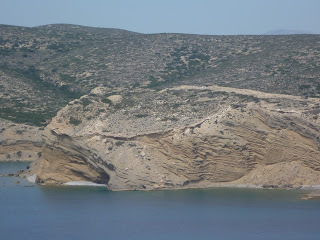

 We drove back to sleepy Kattavia, a small village with an enormous church built by those who left to start new lives in America. It was now well into the afternoon. Penelope’s restaurant was open, run by a friendly Russian woman who said they were open all year to cater to the people working on the power station. Yiannis asked her how the people of Kattavia felt.‘Better they build it! New hotels are opening all the time. In the summer we need seven fridges just for this place. Imagine how much power the big hotels need!’ We ate excellent stuffed cabbage leaves, horta and moussaka, then drove north.
We drove back to sleepy Kattavia, a small village with an enormous church built by those who left to start new lives in America. It was now well into the afternoon. Penelope’s restaurant was open, run by a friendly Russian woman who said they were open all year to cater to the people working on the power station. Yiannis asked her how the people of Kattavia felt.‘Better they build it! New hotels are opening all the time. In the summer we need seven fridges just for this place. Imagine how much power the big hotels need!’ We ate excellent stuffed cabbage leaves, horta and moussaka, then drove north.
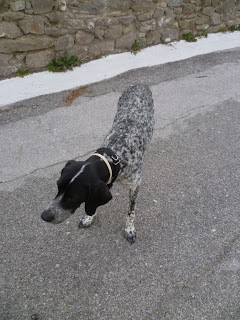 Kattavia to Lahania
Kattavia to LahaniaFrom the coast we turned inland and up into the hills of south Rhodes, where once-cultivated terraces were now thickly blanketed with pine trees and green bushes and liberally sprinkled with white and pink flowers. Suddenly a wonderful view of the long ridges of Karpathos rose from the mist over a flat-calm sea. The road long, winding, empty road led all the way to Mesanagros. A lean dog approached and dropped a stone at my feet. When I walked on, the dog picked up the stone in his mouth and dropped it by my feet again, looking up expectantly. Yiannis picked up the stone and threw it; the dog flew to life, retrieved the stone and lolloped back to drop the stone at Yianni’s feet. And thus we made our way around Mesanagros.
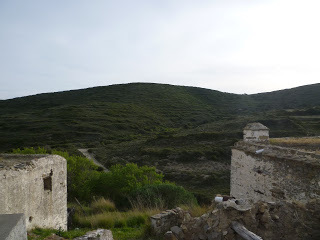


 It was a pretty village with a lively group of local men in the kafeneion – but no rooms to rent. They told us we’d find rooms in Lahania and so we continued through green hills dotted with chapels. There are two places to stay in Lahania; one is in the rooms and restaurant run by the priest and his wife Chrissy, where we stayed. The Greek Orthodox Church says that a man can’t become a priest and then marry; but a married man can become a priest. The priest of Lahania had already had a career as a barber in Baltimore and was married with children and a business when he returned home and became a man of the cloth. He swiftly showed me photos of himself in Dutch and German guidebooks.Lahania (which means ‘the cabbage plant’) was actually a rather handsome and once prosperous village with grand stone doorways to homes hundreds of years old. At dusk, we stood on the balcony of the taverna Platanos by the church, listening to many birds singing in the lush valley below where a path led towards the sea. Swallows flew overhead. Then we returned to the priest’s place for a drink.Once the village had 800 people who worked the fields all around, with the port of Plimmiri below; by the 1960s it was busy with foreign tourists; now many of the well-restored homes were owned by foreigners. The local folks of Lahania still grew some watermelons and potatoes and wheat, and grapes for wine, and thanks to a dam, they had water. And they were making money from the power station people. ‘We need it, because of the new hotels being built in Plimmiri, for thousands of tourists. It won’t pollute – they know how to do these things these days.’ Chrissy was frying potatoes for the family and gave us a plate to go with the wine. Their little grandson trundled by on a toy truck full of potatoes, and the priest tried to teach him to sell us the potatoes. But the boy refused, close to tears. ‘They’re mine!’After a night of being woken by the heating unit cranking into life I got up early, scratching my insect bites. Tiptoeing across dirty bits of carpet, I found no hot water the bathroom, a used bar of soap and a clump of hair on the shower cord. I skipped the shower and went straight to the breakfast of a frothless Greek coffee slopped into the saucer, with processed bread, margarine and cheese slices served by Chrissy who, like the priest, had a few little smears and spills on her clothes. We got on the road, laughing about our memorable night in Lahania.
It was a pretty village with a lively group of local men in the kafeneion – but no rooms to rent. They told us we’d find rooms in Lahania and so we continued through green hills dotted with chapels. There are two places to stay in Lahania; one is in the rooms and restaurant run by the priest and his wife Chrissy, where we stayed. The Greek Orthodox Church says that a man can’t become a priest and then marry; but a married man can become a priest. The priest of Lahania had already had a career as a barber in Baltimore and was married with children and a business when he returned home and became a man of the cloth. He swiftly showed me photos of himself in Dutch and German guidebooks.Lahania (which means ‘the cabbage plant’) was actually a rather handsome and once prosperous village with grand stone doorways to homes hundreds of years old. At dusk, we stood on the balcony of the taverna Platanos by the church, listening to many birds singing in the lush valley below where a path led towards the sea. Swallows flew overhead. Then we returned to the priest’s place for a drink.Once the village had 800 people who worked the fields all around, with the port of Plimmiri below; by the 1960s it was busy with foreign tourists; now many of the well-restored homes were owned by foreigners. The local folks of Lahania still grew some watermelons and potatoes and wheat, and grapes for wine, and thanks to a dam, they had water. And they were making money from the power station people. ‘We need it, because of the new hotels being built in Plimmiri, for thousands of tourists. It won’t pollute – they know how to do these things these days.’ Chrissy was frying potatoes for the family and gave us a plate to go with the wine. Their little grandson trundled by on a toy truck full of potatoes, and the priest tried to teach him to sell us the potatoes. But the boy refused, close to tears. ‘They’re mine!’After a night of being woken by the heating unit cranking into life I got up early, scratching my insect bites. Tiptoeing across dirty bits of carpet, I found no hot water the bathroom, a used bar of soap and a clump of hair on the shower cord. I skipped the shower and went straight to the breakfast of a frothless Greek coffee slopped into the saucer, with processed bread, margarine and cheese slices served by Chrissy who, like the priest, had a few little smears and spills on her clothes. We got on the road, laughing about our memorable night in Lahania.
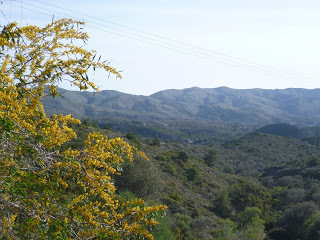 Monolithos to Ayios IsidorosWe drove all the way back through the hills again, passing the dirt track that follows the spine of the island. Back down on the coast were flat wheat fields edged by stark rocks. On the way from Apolakkia to Monolithos there was a long limestone ridge above a pine-filled valley leading down to blue sea. Monolithos bristled with signs (‘Best View!’) to lure in daytrippers and I was tired, so we drove past the castle built by the Knights of St John on a steep rock poking up from the hillside and then parked and walked down a steep, shingle path to beautiful Ayios Georgios beach, where we swam in clear water then fell asleep on the sand.
Monolithos to Ayios IsidorosWe drove all the way back through the hills again, passing the dirt track that follows the spine of the island. Back down on the coast were flat wheat fields edged by stark rocks. On the way from Apolakkia to Monolithos there was a long limestone ridge above a pine-filled valley leading down to blue sea. Monolithos bristled with signs (‘Best View!’) to lure in daytrippers and I was tired, so we drove past the castle built by the Knights of St John on a steep rock poking up from the hillside and then parked and walked down a steep, shingle path to beautiful Ayios Georgios beach, where we swam in clear water then fell asleep on the sand.
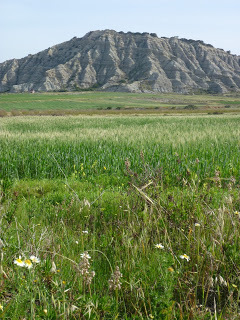

 Refreshed, we drove on, up to the slopes of Attaviros, the island’s highest mountain. Since my first visit to the village of Ayios Isidoros a few years back, I’ve wanted to return and we hoped to stay the night; alas, the community guest house was being fixed up for Easter so we couldn’t. But we stopped for lunch at To Aletro, where swallows were building a nest in the wooden beams over the terrace.I looked out over the hills we’d driven up from. One day, I thought, a walk from Kattavia to here… The owner of To Aletro pointed out a tiny pointed hill far in the distance: Zambika. It felt like ages since we’d stopped there. He said you could walk from here to the top of Attaviros, or down to Profilia.We ate a good Greek salad, potatoes from the oven, and delicious chickpea fritters (revithokeftedes). The village’s own wine from last year was already finished, he said. ‘The European Union gave farmers here money to pull up their vines, and the small farmers who kept their vines but don’t have their own winery and sell the grapes to CAIR, wait two years for their money.’
Refreshed, we drove on, up to the slopes of Attaviros, the island’s highest mountain. Since my first visit to the village of Ayios Isidoros a few years back, I’ve wanted to return and we hoped to stay the night; alas, the community guest house was being fixed up for Easter so we couldn’t. But we stopped for lunch at To Aletro, where swallows were building a nest in the wooden beams over the terrace.I looked out over the hills we’d driven up from. One day, I thought, a walk from Kattavia to here… The owner of To Aletro pointed out a tiny pointed hill far in the distance: Zambika. It felt like ages since we’d stopped there. He said you could walk from here to the top of Attaviros, or down to Profilia.We ate a good Greek salad, potatoes from the oven, and delicious chickpea fritters (revithokeftedes). The village’s own wine from last year was already finished, he said. ‘The European Union gave farmers here money to pull up their vines, and the small farmers who kept their vines but don’t have their own winery and sell the grapes to CAIR, wait two years for their money.’
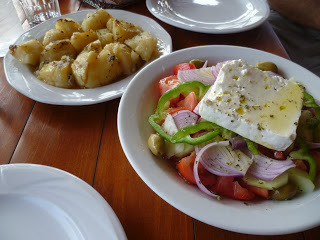

Ayios Isidoros to EmbonaIt’s not far around the mountain to Embona, where we would stay for the night; but we took a long route through the rolling green foothills and past the dammed river, the fragma that’s so important for the water supply. At one stop, I found the antler of a deer, a couple of feet long: the dama-damaor fallow deer of Rhodes live around here. At another, while Yiannis took photos from a river, I walked up a hill full of flowers – a dozen or more different types. We passed through Apollona, surprisingly lively and with seemingly nothing for tourists, just a little village surrounded by farmland. Thankfully there are still places that way in this middle part of the island.





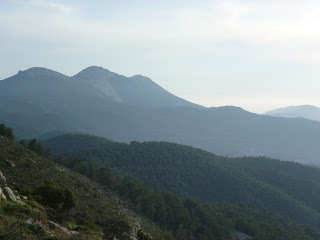
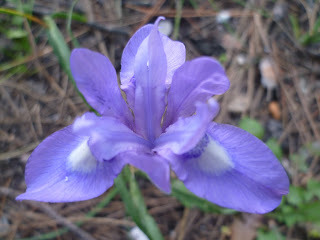 Arriving at Embona, the wine-making centre of Rhodes, we settled into the lovely Attaviros Hotel where I’ve stayed before, and went up the road to Merkouris winery where Anastasia gave us some to taste; they avoid using chemicals so it’s close to organic. Yiannis was going back to Tilos the next day with the car, so I bought ten litres of white athiri and ten of red amorgiano – it works out much cheaper by the box – plus a litre of stronger semi-dry for something different. It felt good to be back in Embona. We wandered around the mountain village; it has over a thousand inhabitants but since it was Sunday evening most restaurants were closing early, so we went for pizza. I had a few days before I was expected in Lindos, and hadn’t yet decided where to go. I’d been thinking of going to Karpathos, but decided to wait until I had more time (and now I’m glad I did – stay tuned!). I’d thought of going back to Pserimos and Petroula said her father would take me across from Kalymnos in his boat, but if the weather turned windy I could get stuck there. Why not stay in Embona? Yet I didn’t want to miss the chance to finish our loop of the island.
Arriving at Embona, the wine-making centre of Rhodes, we settled into the lovely Attaviros Hotel where I’ve stayed before, and went up the road to Merkouris winery where Anastasia gave us some to taste; they avoid using chemicals so it’s close to organic. Yiannis was going back to Tilos the next day with the car, so I bought ten litres of white athiri and ten of red amorgiano – it works out much cheaper by the box – plus a litre of stronger semi-dry for something different. It felt good to be back in Embona. We wandered around the mountain village; it has over a thousand inhabitants but since it was Sunday evening most restaurants were closing early, so we went for pizza. I had a few days before I was expected in Lindos, and hadn’t yet decided where to go. I’d been thinking of going to Karpathos, but decided to wait until I had more time (and now I’m glad I did – stay tuned!). I’d thought of going back to Pserimos and Petroula said her father would take me across from Kalymnos in his boat, but if the weather turned windy I could get stuck there. Why not stay in Embona? Yet I didn’t want to miss the chance to finish our loop of the island.
Embona to RhodesAnd so the next morning we descended the mountain on a winding road, passed the medieval castle at Kritinias and just before Kameiros Skala we turned down to Kopria beach. It’s an unpromising name – kopria is manure – but the tiny cove of white pebbles was sublime. The best yet. I’d drive with Yianni to Rhodes town, then take the bus back to Embona in the afternoon for a few days of writing and walking…

Published on May 02, 2016 02:33
April 18, 2016
Adventures in Rhodes – Two Nights in Rhodes Town



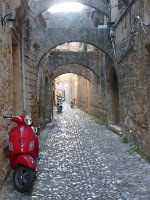
It's the last day of March and we disembark from the Dodecanisos ferry at Kolona Harbour, entering the walls through the huge stone gate. Late afternoon sun spills over Rhodes Old Town.
From Ippokratous Square we walk up Sokratous Street, usually busy with strolling tourists but empty at this time of year with most of the shops still closed. We follow it to the pink Suleiman Mosque at the top, originally built soon after the Ottoman conquest of the city in 1522; turn right before the clock tower, towards the Palace of the Grand Master of the Knights of Rhodes. Built by the Knights Hospitaller in the fourteenth century, its façade was destroyed during Ottoman times but rebuilt by the Italian occupiers during the late 1930s. And there is our hotel, Nikos Takis, its location immersing you at once and unmistakably in the history of Europe’s biggest medieval city.
Nikos Takis Hotel is built in the old quarters of the Sultan’s harem in the nineteenth century, and is decorated in eastern style – this is the tip of Rhodes that noses into the coastline of Asia Minor, after all. The founders of Nikos Takis were fashion designers whose clients included Liz Taylor, Sofia Loren, Maria Callas and Jackie Onassis. I loved my first stay in this historic boutique hotel a few years ago, in the Grand Master Emery suite with its terrace view of cruise ships coming in. With the evenings not quite warm enough for lounging on a terrace, the Ontas suite we get this time is perfect – it's got a warm, opulent feel, decorated in soothing reds and oranges and burnt umbers, with old wooden ceiling beams and a bed you could sink a small submarine in. There are hand-painted details and swathes of brocade and silk. I love it. And the welcome is very friendly, there are only eight rooms, and it’s open year-round.



I like the happy, relaxed mood on any Greek island when shops and restaurants are just opening and the weather is mild. In early evening, we wander to find a place to eat. We get talking to someone at the newish bakery and pizzeria Il Forno, in a building which I remember as the lovely bar Angel, and I giggle when he hands us what he called a ‘flyeraki’. He tells us a place where we can get good, authentic food, and it turns out to be the place we eyed earlier, Ta Petaladika, a bright, buzzing fish meze place. As an Old Town resident tells us, any restaurant open now is probably good because it caters to locals. We have grilled calamari, salt cod and skordalia (like garlic mashed potato), and a house salad with rocket and pieces of smoked salmon, washed down with the clear spirit tsipouro – which comes in a nifty holder with ice around it.
Rhodes town feels like coming to the city for us, living on tiny Tilos; it’s where we run our errands, but also good for a break, to eat different foods and meet other people. And of course a lovely hotel makes it even nicer. By the time I wake up next morning in the super-comfortable bed, looking out of the window at the old school lit up with morning sunlight and the blue sky above – Yiannis is already leaning out of the window with his camera – I am relaxed to be on holiday. A few opportunities have come up to explore Rhodes again, and I'm looking forward to it.
After a morning of appointments and shopping – including a browse around a new shop in Mandraki called Eva’s Walk specialising in natural Greek beauty products and food – we sit down to a late lunch at Stavlos. There used to be a bakery here, a couple of streets up from the bus station, but since Theodoraki Street in between has become a happening cafe-bar street for local Beautiful People, this has reinvented itself as a ‘kalofagadiko’ or a place for good food. All around us, young people from Rhodes (and Tilos – look, there’s our football team!) are feasting on gargantuan plates of roast meat and Yiannis orders kebab and chips, but I choose one of my favourite dishes, Cretan dakos, just tomatoes and feta and wholewheat twice-baked bread all heaped together and drowned in olive oil. And I eat half the chips. With a half-litre of cold red wine, it’s just right to send us off to sleep for a while.In early evening, when the light is good for photography, we head out to explore the Old Town once more. I thought I knew every part of this place from my many wanderings over the years, but no - we get delightfully lost and captivated by its intimate corners.

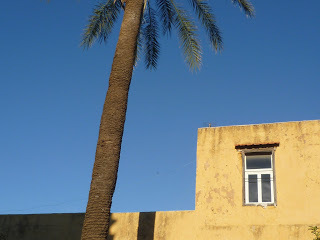
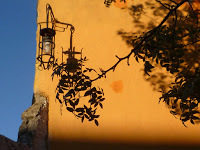
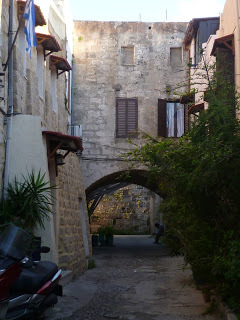


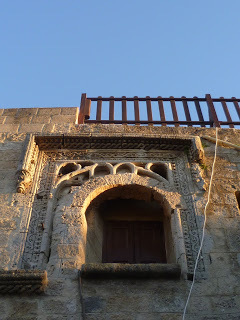


Then we relax back in the room until it’s a reasonable time to find some nightlife, given it’s Friday night and all. Ten o’clock, Yiannis insists, is still far too early to go out but I fear I'll fall asleep if we don't get moving. He's right of course: Legends is still playing some fairly dodgy rock when we arrive but the early start means we bag a couple of seats, have a couple of drinks and eventually the live band starts close to midnight. After the first set we move on and find a cool new dance bar called Oda just up the alley towards Fuego, where I discover a worrying new enthusiasm for Jaegermeister and a type of music which Yiannis shrugs and says could be called ‘industrial atmospheric’. Next day, he grins and asks if I remember half the things I was talking about. And I don’t. But I don’t care. I’m enjoying myself. I’m on holiday.And we’re off on a road trip around the island.Part Two follows soon!!!!
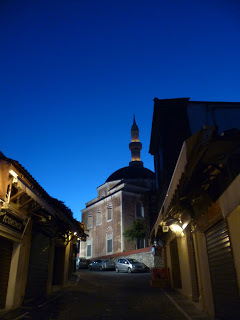
My two nights in Rhodes were courtesy of Nikos Takis Hotel, Panetiou 26, Old Town (22410 70773)Ta Petaladika (‘ouzotaverneion’), Menekleous 8, Old Town (22410 27319) Stavlos (‘kalofagadiko’), corner of Tarpon Springs and Karpathou (22410 77180)
Published on April 18, 2016 11:17
Winner of the Octopus Competition!
You lovely, lovely people. Thank you for sharing the news of the Octopus being released. Which reminds me, did you see this news item? Surely Inky the escaping octopus heard about the ouzo... Or maybe he just fancied a different, more free sort of life, just like I did. But what I meant to say was thank you for sharing the news of An Octopus in my Ouzo. I wish I could give you ALL free copies of the book. But I only have one to offer right now to our winner this week, Roisheen Childs, who said on Twitter she had her tentacles crossed. You can uncross them now!
You all do so much for me but I'm going to ask a favour. If you read my new book and if it's easy for you to do this, it would be great if you would write a review on Amazon UK or on Goodreads or wherever you like. Much appreciated! Reviews help books to get discovered by others who might like them.
Now I'd better stop wittering on, as I have a real blog post to finish...
You all do so much for me but I'm going to ask a favour. If you read my new book and if it's easy for you to do this, it would be great if you would write a review on Amazon UK or on Goodreads or wherever you like. Much appreciated! Reviews help books to get discovered by others who might like them.
Now I'd better stop wittering on, as I have a real blog post to finish...
Published on April 18, 2016 09:17



